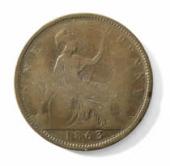
PREV ARTICLE
NEXT ARTICLE
FULL ISSUE
PREV FULL ISSUE
V11 2008 INDEX
E-SYLUM ARCHIVE
QUERY: WHAT IS THE SIGNIFICANCE OF ROYAL MINT DIE NUMBERS?
Dick Johnson submitted the following query, which had me
perplexed initially, too. I found a little information (see below), but
comments from readers are welcome. -Editor.
Here's a question for
our most knowledgeable E-Sylum readers: What does a number, 2 through 5,
under a date, in this case on an 1863 English penny, signify? One just
sold last week at auction in North Yorkshire England with a 5 under the
date for £17,500 ($34,680 U.S.). The buyer was from Scotland. The auction
firm claims the figures 2 through 4 were known on specimens beforehand,
but this is the first one bearing a 5. When I first read the news report
in The Press of Britton (in stilted British newsease) -- "The number five
die coin, which dates back to 1863, was bought ..." -- I wondered what
kind of a coin had five dies. No, the number 5 is ON the die. Were they
serially numbering the dies? Was this struck in the 5th month? Did the
mintmaster -- or the pressman -- have this number to identify his
production? Pray tell, enlighten me.Here are excerpts from the article. -Editor.
 A rare English penny has been sold at auction in
North Yorkshire for a record-breaking £17,500.
A rare English penny has been sold at auction in
North Yorkshire for a record-breaking £17,500.The number five die coin, which dates back to 1863, was bought by a private collector from Scotland last week as part of a £176,000 sale at Tennants Auctioneers, Leyburn.
Thought to be the only one of its type in existence, the coin had been stamped with a die number below the date, a practice introduced by the Mint in the 1860s for unknown reasons.
Die numbers two, three and four have already been found, but a number five die penny has never been recorded until now.
The penny was inspected by Royal Mint authorities, including the chief engraver, who shared the view that the figure beneath the date was indeed a five.
Jeff Gardiner, of Tennants Auctioneers, said: "There were reports of another number five die coin about 20 years ago, but we agree that this was probably that same coin and that in fact there is only one in existence.
Image from AuctionPublicity.com. To view the complete press release, see: Unique, Unrecorded 1863 Penny turns up
To read the complete article, see: Rare coin sells for £17,500
I did find a mention of the die numbering practice on Tony
Clayton's Coins of
England and Great Britain site: "Between 1863 and 1880 silver and gold
coins issued by the Royal Mint for circulation in the UK and its
possessions had a die number inscribed on them." But just what was the
purpose of the numbering, and what did the numbers signify?
I pulled off the shelf my copy of Spink's Coins of England and the United Kingdom (41st edition, 2006). On p404, in the preface to the section on the coins of Queen Victoria (1837-1901), the author states:
I pulled off the shelf my copy of Spink's Coins of England and the United Kingdom (41st edition, 2006). On p404, in the preface to the section on the coins of Queen Victoria (1837-1901), the author states:
Between 1863 and 1880 reverse dies of the gold and silver
were numbered in the course of Mint experiments into the wear of dies. The
exception was the Florin where the die number is on the obverse below the
bust.
But that mention discusses only silver and gold coins. What
about copper pennies? -Editor. THE JOB BAZARRE
Wayne Homren, Editor
The Numismatic Bibliomania Society is a non-profit organization promoting numismatic literature. See our web site at coinbooks.org.
To submit items for publication in The E-Sylum, write to the Editor at this address: whomren@gmail.com
To subscribe go to: https://my.binhost.com/lists/listinfo/esylum
All Rights Reserved.
NBS Home Page
Contact the NBS webmaster
